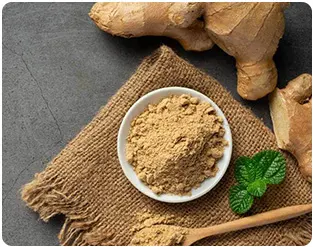
Ginger goes through a laborious process, aided by strict quality control methods, from its humble origins on a ginger farm through its transformation into a fine powder. Ginger powder manufacturers make these steps essential to ensuring that the ginger powder maintains its flavor, aroma, and nutritional content and provides consumers with a high-quality product.
Quality is a top priority for ginger powder manufacturers from the beginning of the sourcing process. They work with reputable suppliers who grow ginger using eco-friendly agricultural methods. It guarantees that the ginger used to make the powder is free of pollutants like pesticides and other chemicals. Ginger Powder Suppliers ensure that the finished product meets the highest standards of excellence by upholding strict quality control procedures.
1. Cultivation
The trip starts at ginger farms, where ginger plants flourish in warm, tropical climes. For optimum development, it loves partially shaded, well-drained soil. The ginger rhizomes (rootstalks) are carefully planted in the soil by farmers, who make sure they are sufficiently spaced apart to allow for growth.
2. Cleaning and Washing
The ginger rhizomes are thoroughly cleaned after being picked. Farmers gently wash the ginger roots to get rid of any extra dirt and debris. This step is essential to ensuring that the ginger is clean and prepared for processing. The ginger powder is carefully packaged after being ground to maintain its purity and freshness. It is frequently packed or sealed in airtight containers or bags to shield it from moisture and light.
3. Harvesting and Post-Harvest Management
Proper harvesting is the first step in guaranteeing quality. It’s crucial to harvest ginger when it’s fully mature, typically when the leaves begin to turn yellow. The integrity of the ginger rhizomes is preserved through careful handling throughout the harvest, including preventing damage and bruising. Cleaning, sorting, and removing broken or diseased ginger are just a few post-harvest handling procedures that are essential for preventing contamination and maintaining quality.
4. Cleaning and Sanitizing
Ginger is thoroughly washed after harvesting to get rid of any residue, dirt, or other impurities. To reduce microbiological contamination and guarantee food safety, high-quality water, and sanitizers developed for use on food are utilized. Cross-contamination during processing is avoided by strict adherence to hygiene practices, such as routine equipment cleaning and sanitization.
5. Drying Techniques
The ginger powder suppliers ensure that the rhizomes are prepared for drying after cleaning. A crucial stage in turning fresh ginger into ginger powder is drying. Ginger can be dried using a variety of techniques, including mechanical, air, and solar processes. The ginger rhizomes are spread out and exposed to the heat and wind of the sun to be dried.
This traditional approach may take many days or even weeks, depending on the weather. Another typical method is air drying, which involves putting ginger rhizomes in well-ventilated spaces or drying chambers. Mechanical drying requires the use of specialized drying apparatus with regulated temperature and airflow to dry the ginger effectively.
The drying process is important because it draws out the moisture in ginger, prolongs its shelf life, and enhances its flavor and odor. Ginger keeps its medicinal properties and is simple to powderize when dried properly.
Also Read: Understanding How Powdered Ginger in India Holds Its Worth
6. Milling and Grinding
The ginger is processed through milling and grinding after it has dried to create a fine powder. To produce the necessary particle size and texture, cutting-edge grinding and milling equipment is used by ginger powder exporters. Strict quality control procedures, like routine equipment calibration, guarantee uniformity in the finished product. It’s crucial to avoid cross-contamination between batches if you want to keep the ginger powder pure and high-quality.
7. Storage and Packaging
The preservation of ginger powder’s quality and shelf life is greatly aided by packaging. Premium packaging materials, including moisture-proof and light-resistant containers, are employed to shield the powder from moisture, light, and oxygen. Traceability and quality control are made possible by proper labeling that contains all necessary information, such as the batch number and date of packaging.
In order to prevent quality deterioration, storage conditions must be appropriate. Ginger powder manufacturers ensure to keep it out of direct sunlight and pungent odors in cool, dry places with good ventilation. The ginger powder is kept fresh and keeps its quality over time by routinely checking storage conditions, including temperature and humidity levels.
8. Tests and Quality Assurance
The job of quality assurance is crucial at every stage of the process, from the farm to the ginger powder. Regular inspections, sampling, and testing are carried out to monitor and maintain quality standards. It comprises laboratory testing to look for microbiological contaminants, heavy metals, and adulterants, as well as sensory evaluation, to judge flavor, aroma, and appearance. Corrective actions are triggered whenever quality standards are violated to quickly fix problems.
9. Distribution and Consumption
Ginger powder travels from the packing plants to numerous markets and grocery stores before being consumed. It is distributed both locally and worldwide before arriving on store shelves and being bought for use in cooking by both amateur cooks and trained chefs.
Conclusion
Ginger powder manufacturers go through several phases on their way from the farm to ginger powder, each needing rigorous adherence to quality control procedures. Every process is carefully carried out to maintain the freshness, flavor, and nutritional content of ginger, starting with the harvest and handling afterward and continuing through washing, drying, grinding, packaging, and storage. Producers ensure that the ginger powder given to consumers is of the best quality by ongoing testing, monitoring, and adherence to standards, enhancing culinary experiences and benefiting from its therapeutic characteristics.
In a variety of dishes, ginger powder is used in the kitchen. It gives savory foods like marinades, curries, and stir-fries warmth and depth. Additionally, ginger powder is frequently used in baking, giving gingerbread, cakes, and cookies their characteristic flavor. Due to its adaptability, it is a necessary spice for both conventional and modern cooking.